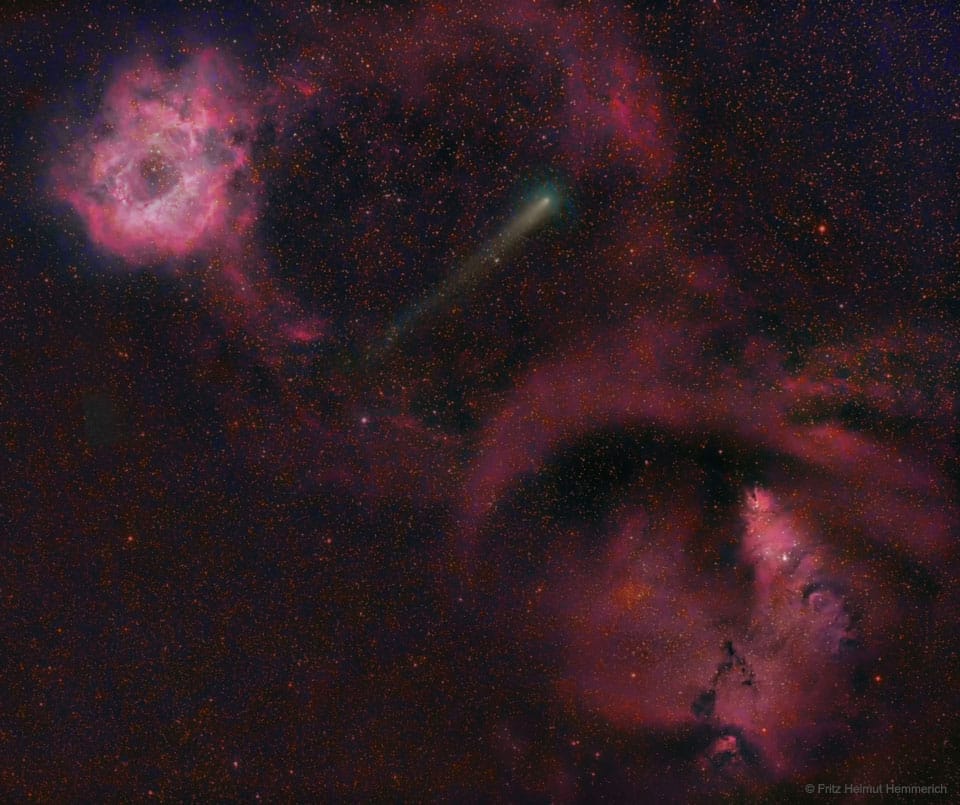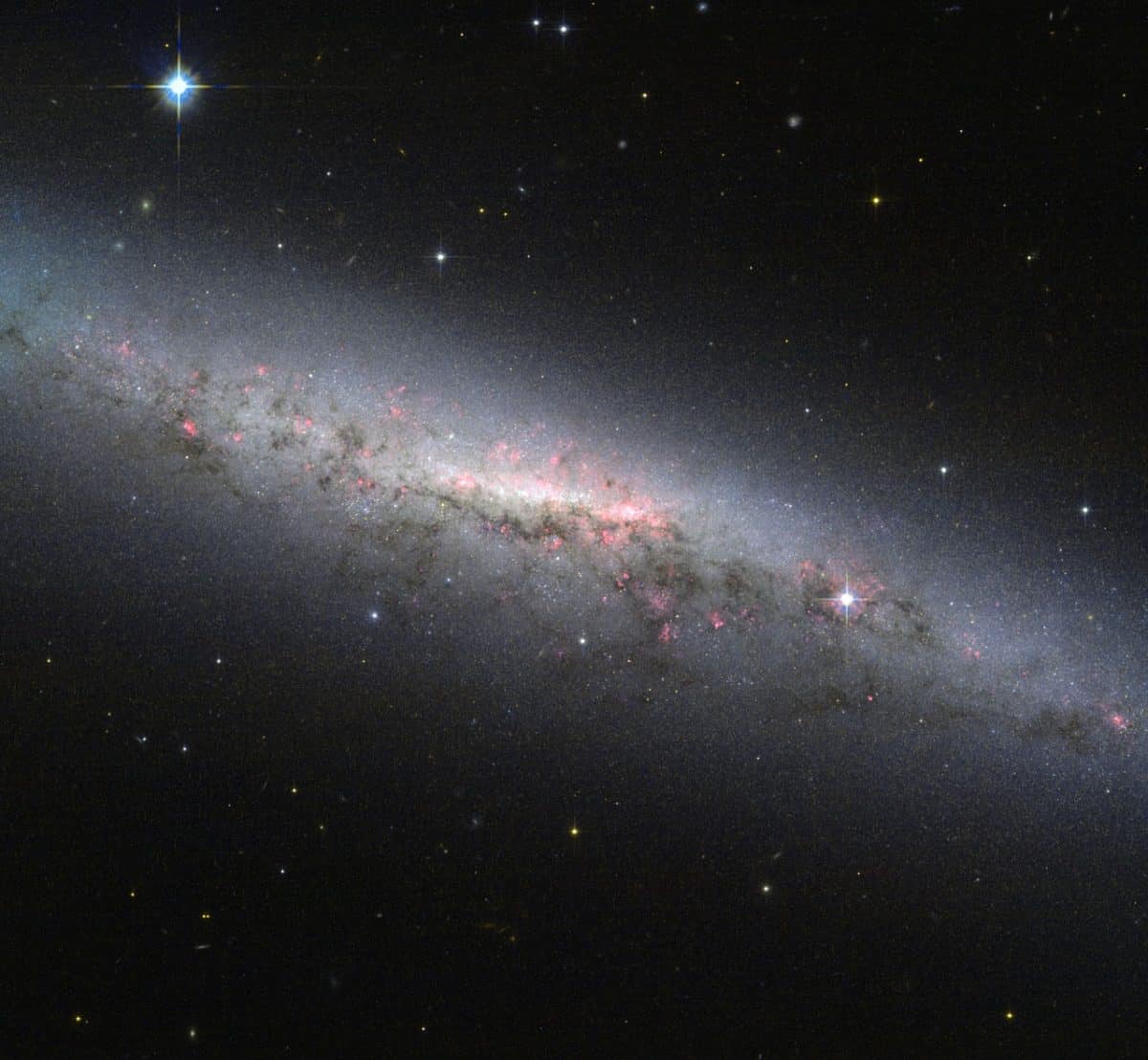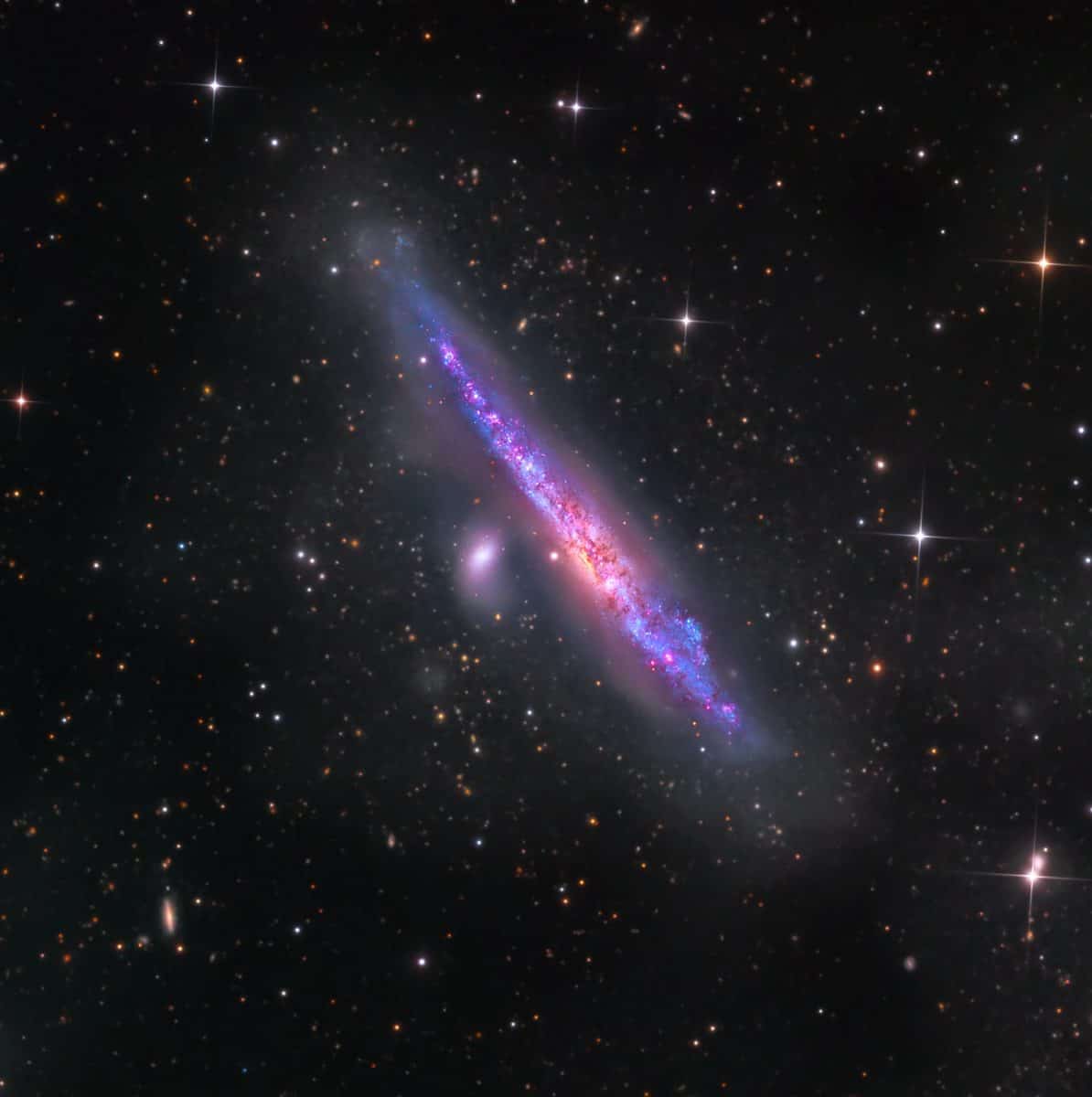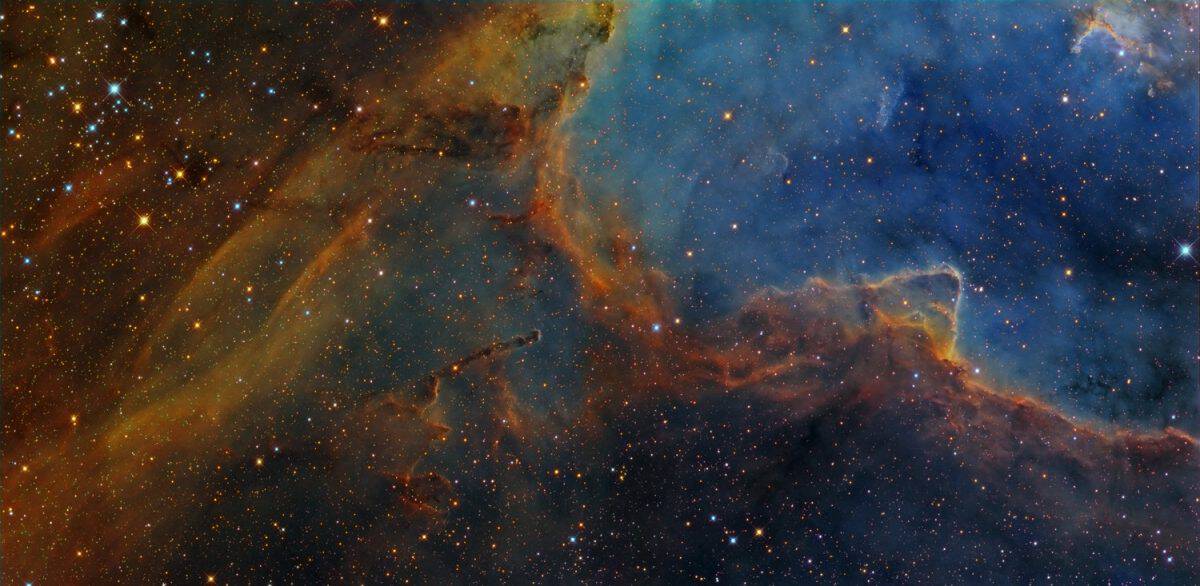Blog
Small bits of this greenish-gray comet are expected to streak across Earth’s atmosphere tonight. Specifically, debris from the eroding nucleus of Comet 21P / Giacobini-Zinner, pictured, causes the annual Draconids meteor shower, which peaks this evening. Draconid meteors are easy to enjoy this year because meteor rates will likely peak soon after sunset with the Moon’s glare nearly absent. Patience may be needed, though, as last month’s passing of 21P near the Earth’s orbit is not expected to increase the Draconids’ normal meteor rate this year of (only) a few meteors per hour. Then again, meteor rates are notoriously hard to predict, and the Draconids were quite impressive in 1933, 1946, and 2011. Featured, Comet 21P gracefully posed between the Rosette (upper left) and Cone (lower right) nebulas two weeks ago before heading back out to near the orbit of Jupiter, to return again in about six and a half years.
more...Park Frederick “Pepper” Adams III (October 8, 1930 – September 10, 1986) was an American jazz baritone saxophonist and composer. He composed 42 pieces, was the leader on eighteen albums spanning 28 years, and participated in 600 sessions as a sideman. He worked with an array of musicians, and had especially fruitful collaborations with trumpeter Donald Byrd and as a member of the Thad Jones/Mel Lewis Big Band.
Pepper Adams was born in Highland Park, Michigan, to father Park Adams II and mother Cleo Marie Coyle. Both of his parents were college graduates, with each spending some time at the University of Michigan. Due to the onset of the Great Depression, Adams’ parents separated to allow his father to find work without geographic dependence. In the fall of 1931 Adams moved with his mother to his extended family’s farm near Columbia City, Indiana, where food and support were more readily available. In 1933 Adams began playing piano. His family moved to Rochester, New York, in 1935 and in that city he began his musical efforts on tenor sax and clarinet. Two years later Adams began deepening his developing passion for music by listening to Fats Waller‘s daily radio show. He was also influenced at a young age by listening to Fletcher Henderson‘s big band radio broadcasts out of Nashville, Jimmie Lunceford, Duke Ellington, and Cab Calloway. Adams would later describe “[his] time up until the age of eight or so [as] really just traveling from one place to another”. As early as 4th grade, Adams sold cigarettes and candy door-to-door in order to contribute to his family’s income for essential items.
more...Johnie Lewis (born October 8, 1908 at Eufaula , Barbour County , Alabama , October 6, 1992 in Chicago ) was an American country blues and gospel musician ( vocals , guitar , and harmonica , Kazoo ).
Lewis grew up on a farm near Eulala in Alabama and Georgia . He spent most of his adult life in Chicago, where he moved in the 1930s and performed in small clubs. His musical role models were Tampa Red , Barbecue Bob and Blind Lemon Jefferson . Through his main job as a house painter , he made acquaintance with the filmmaker Harley Cokliss , who filmed a documentary about the Chicago Blues . His appearance in the film, in which he presents songs like Hobo Blues and When I’m Gone , led to recording sessions for Arhoolie Records in the early 1970s and the LP Alabama Slide Guitar . The Chicago-based album featured a number of Country Blues and Spirituals such as the songs dedicated to the Martin Luther King You Gonna Miss Me , I Got to Climb a High Mountain , and My Little Gal (with Charlie Musselwhite ).
more...Kocani Orkestar, Macedonia’s most accomplished and best-known gypsy brass band, featured in the film “Time of the Gypsies” and take their name from a nearby town on the outskirts of Skopje, where such music is known to this day as romska orientalna muzika (?oriental gypsy band?).
more...A gorgeous new photo by the Hubble Space Telescope confirms that a faraway spiral galaxy is indeed churning out new stars at a rapid rate.
The new Hubble image captures a galaxy called NGC 7090, which is found about 30 million light-years from Earth in the southern constellation Indus (The Indian). The edge-on shot shows the galaxy’s disc and bulging central core — which is likely full of cool, relatively old stars — as well as a number of pinkish regions scattered throughout NGC 7090.
These pink areas reveal the presence of huge clouds of hydrogen gas, researchers said. Such clouds are the raw materials of which stars are made, providing striking visual confirmation of several recent studies that have classified NGC 7090 as a star-forming galaxy.
more...Larry Young (also known as Khalid Yasin [Abdul Aziz]; 7 October 1940 in Newark, New Jersey – 30 March 1978 in New York City) was an American jazz organist and occasional pianist. Young pioneered a modal approach to the Hammond B-3 (in contrast to Jimmy Smith‘s soul jazz style). However, he did also play soul jazz, among other styles.
Young played with various R&B bands in the 1950s before gaining jazz experience with Jimmy Forrest, Lou Donaldson, Kenny Dorham, Hank Mobleyand Tommy Turrentine. Recording as a leader for Prestige from 1960, Young made a number of soul jazz discs, Testifying, Young Blues and Groove Street. When Young signed with Blue Note around 1964, his music began to show the marked influence of John Coltrane. In this period, he produced his most enduring work. He recorded several times as part of a trio with guitarist Grant Green and drummer Elvin Jones, occasionally augmented by additional players; most of these albums were released under Green’s name, though Into Somethin’ (with Sam Rivers on saxophone) became Young’s Blue Note debut. Unity, recorded in 1965, remains his best-known album; it features a front line of Joe Henderson and the young Woody Shaw. Subsequent albums for Blue Note (Contrasts, Of Love and Peace, Heaven On Earth, Mother Ship) also drew on elements of the ’60s avant-garde and utilised local musicians from Young’s hometown of Newark. Young then became a part of some of the earliest fusion groups: first on Emergency! with the Tony Williams Lifetime (with Tony Williams and John McLaughlin) and also on Miles Davis‘s Bitches Brew. His sound with Lifetime was made distinct by his often very percussive approach and often heavy use of guitar and synthesizer-like effects. He is also known for a jam he recorded with rock guitarist Jimi Hendrix, which was released after Hendrix’s death on the album Nine to the Universe.
more...Mel Brown (October 7, 1939 – March 20, 2009) was an American-born blues guitarist and singer.
Brown was nominated for a Juno Award in both 2001 and 2002.
For many years in the 1980s and 1990s, Brown was a prominent member of the house band at Antone’s Night Club in Austin, Texas.
Brown died aged 69, on March 20, 2009, in Kitchener, Ontario, of complications from emphysema.
One of his most celebrated tracks is the 11+ minute guitar solo, “Eighteen Pounds of Unclean Chitluns”, which is on I’d Rather Suck My Thumb(1970), and was reissued as the lead track (and title) on a BluesWay Records collection released in 1973.
A documentary film, Love Lost & Found: The Story of Mel Brown directed by Sean Jasmins for Blue Fusion Productions was granted a theatrical release in 2014.
more...Jonathan David Samuel Jones (October 7, 1911 – September 3, 1985) was an American jazz drummer. A band leader and pioneer in jazz percussion, Jones anchored the Count Basie Orchestra rhythm section from 1934 to 1948. He was sometimes known as Papa Jo Jones to distinguish him from younger drummer Philly Joe Jones.
Born in Chicago, Illinois, Jones moved to Alabama, where he learned to play several instruments, including saxophone, piano, and drums. He worked as a drummer and tap-dancer at carnival shows until joining Walter Page‘s band, the Blue Devils in Oklahoma City in the late 1920s. He recorded with trumpeter Lloyd Hunter‘s Serenaders in 1931, and later joined pianist Count Basie‘s band in 1934. Jones, Basie, guitarist Freddie Green and bassist Walter Page were sometimes billed as an “All-American Rhythm section,” an ideal team. Jones took a brief break for two years when he was in the military, but he remained with Basie until 1948. He participated in the Jazz at the Philharmonic concert series.
He was one of the first drummers to promote the use of brushes on drums and shifting the role of timekeeping from the bass drum to the hi-hatcymbal. Jones had a major influence on later drummers such as Buddy Rich, Kenny Clarke, Roy Haynes, Max Roach, and Louie Bellson. He also starred in several films, most notably the musical short Jammin’ the Blues (1944).
https://www.youtube.com/watch?v=z8SQzu5qNNM
more...Mansi people live in Siberia and speak finno-ugric Mansi language.
more...https://www.youtube.com/watch?v=FQo8r3f9tsA
more...https://www.youtube.com/watch?v=FQo8r3f9tsA
more...Taken from DGRO Rancho Hidalgo Animas, New Mexico
14.5″ RCOS F8 Apogee U16M High Cooling.
Luminance 1200 1×1, RGB 1×1 20 min subs, Red 220
Green 200, Blue 240
NGC 4631 is a big beautiful spiral galaxy. Seen edge-on, it lies only 25 million light-years away in the well-trained northern constellation Canes Venatici. The galaxy’s slightly distorted wedge shape suggests to some a cosmic herring and to others its popular moniker, The Whale Galaxy. Either way, it is similar in size to our own Milky Way. In this sharp color image, the galaxy’s yellowish core, dark dust clouds, bright blue star clusters, and red star forming regions are easy to spot. A companion galaxy, the small elliptical NGC 4627 is just above the Whale Galaxy. Faint star streams seen in deep images are the remnants of small companion galaxies disrupted by repeated encounters with the Whale in the distant past. The Whale Galaxy is also known to have spouted a halo of hot gas glowing in X-rays.
more...Mark Whitfield (born October 6, 1966) is an American jazz guitarist.
Whitfield was born in Lindenhurst, New York. He is probably better known for his recordings as bandleader for both the Verve and Warner Bros. Records record labels. He has worked with Jack McDuff, Jimmy Smith, Courtney Pine and Nicholas Payton, Chris Botti, among others.
In 2000, Whitfield released an instructional guitar video titled Mark Whitfield: Star Licks Master Sessions, for Star Licks Productions.
On December 21, 2012 Mark played live with the Dave Matthews Band on two of their songs, “Mercy” and “Crash Into Me“, at a concert at the Barclay’s Center in Brooklyn, New York. He recently also reprised his accompaniment on two occasions during the 2013 summer tour again with “Mercy” (June 8, 2013; Hartford, CT) and with “If Only” and “Crash Into Me” (July 13, 2013; Hershey, PA).
more...Millicent Dolly May Small, CD (born 6 October 1946), is a Jamaican singer-songwriter, best known for her 1964 recording of “My Boy Lollipop“.
Small was born at Gibraltar in Clarendon, Jamaica, the daughter of a sugar plantation overseer. Like many Jamaican singers of the era, her career began by winning the Vere Johns Opportunity Hour talent contest, which she won at the age of twelve. Wishing to pursue a career as a singer she moved to live with relatives in Love Lane in Kingston. In her teens, she recorded a duet with Owen Gray (“Sugar Plum”) in 1962 and later recordedwith Roy Panton for Coxsone Dodd‘s Studio One record label as ‘Roy and Millie’.They had a local hit with “We’ll Meet”.
more...Little Sonny (born Aaron Willis, October 6, 1932, Greensboro, Alabama) is an American electric blues harmonica player, singer and songwriter.His early mentor and inspiration was Sonny Boy Williamson II. Nevertheless, Little Sonny stated that his nickname was originated by his mother: “[She] called me ‘Sonny boy’ from the time I can remember.” He has released eight albums, including three for a subsidiary of Stax Records. His 1973 release, Hard Goin’ Up, reached the Top 50 in the Billboard R&B chart.
Willis was born in 1932 and raised solely by his mother. He relocated to Detroit in 1953. He had no real interest in music, he said, “But then I saw Sonny Boy Williamson II.” Willis was “spellbound at the way he played. After the show I went home and practiced for hours. Every day after that I would practice until I got the sound I wanted.” His daytime job was working in a used car lot.
His first professional appearance was at the Good Times Bar in Detroit, playing in Washboard Willie‘s backing group. He put together his first band in March 1956. For the following fifteen years he performed in numerous Detroit clubs, often boosting his earnings by photographing customers between his performances on stage. He often performed with John Lee Hooker, Eddie Kirklandand Baby Boy Warren.
more...NGC 1027 is an open cluster in the constellation Cassiopeia. It was discovered by William Herschel in 1787. It is visible at the eastern part of the constellation, between two emission nebulae, the Heart and Soul Nebula. However, it is not physically associated with the two nebulae, lying in the foreground, about 3,000 light years away from the Solar System. The apparent magnitude of the cluster is 6.7 and can be seen with 10×50 binocularsaround a 7th magnitude star, which is not however member of the cluster. The brightest member of the cluster has apparent magnitude 9,3
The Heart Nebula, IC 1805, Sharpless 2-190, lies some 7500 light years away from Earth and is located in the Perseus Arm of the Galaxy in the constellation Cassiopeia. It was discovered by William Herschel on 3 November 1787. This is an emission nebula showing glowing ionized hydrogengas and darker dust lanes.
The very brightest part of this nebula (the knot at the western edge) is separately classified as NGC 896, because it was the first part of this nebula to be discovered.
The nebula’s intense red output and its configuration are driven by the radiation emanating from a small group of stars near the nebula’s center. This open cluster of stars known as Melotte 15 contains a few bright stars nearly 50 times the mass of our Sun, and many more dim stars that are only a fraction of our Sun’s mass.
more...Clifton Anderson (born October 5, 1957) is an American jazz musician, a trombone player. He grew up surrounded by music. His father was a church organist /choir director, and his mother a singer and pianist. It was no surprise that Clifton exhibited an affinity for music at an early age. When he was just seven years old he got his first trombone, a gift from his famous uncle Sonny Rollins.
Clifton attended the prestigious Fiorello LaGuardia High School of Music and Art. In 1974, he spent one year at the State University of New York at Stony Brook studying under Simon Karasick and Dave Schechter. He continued his education at the Manhattan School of Music, and graduated in 1978 with a Bachelor of Music degree.
At The Manhattan School, he studied under the Metropolitan Opera trombonist John Clark. There he also met and befriended talented musicians including Angela Bofill and the late Kenny Kirkland.
While at Manhattan School of Music, Clifton began freelancing around New York City, making record dates and sitting in at clubs. He participated in jazz organizations like the Muse, the CBA Ensemble and later Barry Harris’s ensemble workshops on 8th Avenue. Clifton made his first record date with Carlos Garnett in 1976. By his senior year, at Manhattan he had established himself as one of the young “in demand” trombonists in New York.
more...More Posts
- Daily Roots with Prince Buster
- The Cosmos with R Aquarii
- Tomasz Stanko Day
- Clyde Bernhardt Day
- World Music with Diali Cissokho & Kaira Ba
- Daily Roots with Linval Thompson
- The Cosmos with NGC 3576
- Bela Fleck Day
- Lee Morgan Day
- Blind Boy Fuller Day
- World Music with Omar Bashir
- Daily Roots with Owen Gray
- The Cosmos with NGC 6300
- Mitch Mitchell Day
- Colin Bailey Day
- World Music with Combo Ginebra
- Daily Roots with Freddie McGregor
- The Cosmos with IRAS 23166+1655
- Jaimoe Day
- Louis Jordan Day



